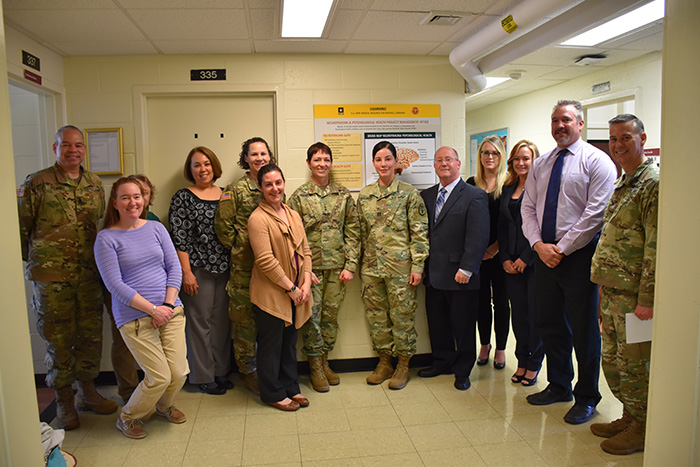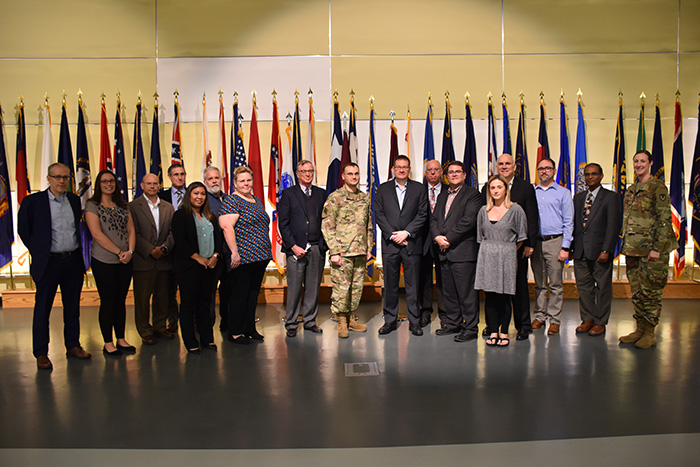Investing in the Health and Safety of Our Warfighters

When it comes to the advancement of military medical products, 2018 was a highly successful year for the men and women of the U.S. Army Medical Materiel Development Activity, Fort Detrick, Maryland. As a subordinate command of the U.S. Army Medical Research and Materiel Command, USAMMDA is tasked with developing and delivering critical medical solutions to protect, treat and sustain the health of our nation's Warfighters. The organization's numerous capabilities in product development are leveraged to help provide various products and devices requested by the military to support and sustain the readiness of our forces. However, the USAMMDA team also focuses on repairing wounded Warfighters who have suffered catastrophic injuries, both visible and those not readily seen, to help restore form and function upon their return from battle.
In light of its unique work, USAMMDA is recognized throughout the Department of Defense and beyond as the premier developer of world-class military medical capabilities. Utilizing a cadre of acquisition professionals, both military and civilian, the organization has garnered a great deal of success since its establishment more than three decades ago. Its specialized teams maintain project management offices for Combat Trauma and Acute Rehabilitation, Medical Support Systems & Evacuation, Neurotrauma & Psychological Health, and Pharmaceutical Systems, while its Force Health Protection Division works to secure urgent medical capabilities when no other U.S. Food and Drug Administration-approved products are available.
Included among its recent achievements, USAMMDA's NPH and Pharmaceutical Systems PMOs witnessed the successful FDA approval of two important military medical products in 2018. The PSPMO received approval for Tafenoquine, a safe and effective weekly drug to prevent malaria and the first new malaria prophylaxis in 18 years, while the NPH PMO's Laboratory Assay for Traumatic Brain Injury program was given FDA approval to market the first-ever blood test used for the detection of mild TBI.
Leading the Fight against Malaria
Malaria is the number one infectious disease threat to U.S. Service Members deployed overseas, and Army Maj. Victor Zottig is fully aware of this statistic.
As USAMMDA's product manager for Tafenoquine, Zottig has been involved with the program since 2016, having spent the prior five years at the Walter Reed Army Institute of Research working on the development of new anti-malarial drugs, and studying anti-malarial therapies, including Tafenoquine.
"Tafenoquine is an incredible asset to military and civilian personnel due to the advantages it offers over currently available medications for treatment and protection against malaria," said Zottig. "The drug is unique among anti-malarial drugs, with activity against all lifecycle stages and species of the malaria parasite which infect humans – no other malaria drug has this capability."
As Zottig explains, Tafenoquine is one of only two drugs that work against the dormant Plasmodium vivax hypnozoite, which causes the relapsing form of malaria. Further, for both military and civilian populations, compliance with taking prophylactic anti-malarial drugs has been a recurring issue due to daily medication requirements, unpleasant side effects, and intolerance to the current medications. Tafenoquine's weekly dosing regimen for deployed or traveling personnel, along with a mild side effect profile will likely improve compliance with taking the medication.
While other approved anti-malarial prophylactic drugs being used today do offer protection against the illness, each may have their drawbacks. For example, Doxycycline requires daily administration at approximately the same time each day to be fully protective, which is difficult to achieve in combat or deployed environments. With Primaquine, Service Members returning from deployments are required to take up to 14 days dosing of the anti-malarial drug, although many rarely complete the full two-week post-deployment treatment regimen. In contrast, Tafenoquine users need only a single dose post-deployment to achieve the same coverage as Primaquine. Finally, Tafenoquine is a chemical derivative of Primaquine, which has been in constant use for over 60 years, and it has not yet shown malaria parasite resistance. Lack of parasite resistance could be a significant advantage of Tafenoquine over other anti-malarial drugs, such as Mefloquine and Malarone, which have been demonstrating resistance.

Because of its broad-spectrum activity and convenient dosing regimen, Tafenoquine's availability will likely result in a measurable improvement in compliance and effectiveness in the prevention of malaria in U.S. forces deployed to malaria-endemic areas around the world. In light of this, Zottig believes the Army's successful research and product development, made possible through DOD funding, will reap substantial benefits in the long run.
"I think the DOD will fully realize its investment when Tafenoquine starts being used by Service Members in malaria-endemic environments and the number of malaria cases decreases," said Zottig. "Although the current number of military malaria cases appear to be low, this is mainly due to leadership's strict enforcement of protective measures, and deployments are in relativity low malaria environments."
"However," he continued, "these low numbers could offer a false sense of security and may lead to lower compliance with malaria prophylaxis. Per our results, Tafenoquine has an enormous potential to protect Service Members from malaria. As these Warfighters remain healthy during deployment to malaria-endemic areas, they will be able to complete their assigned missions at full strength – and the DOD should then be very satisfied with its investment in this product."
With the recent FDA approval of Tafenoquine, USAMMDA's PSPMO team has reached a significant milestone in the global fight against malaria, which should likely impact the future eradication of this devastating disease.
Identifying Brain Injury Early
Finding a solution for the diagnosis and evaluation of mild traumatic brain injury in our wounded Service Members has been a DOD top priority for more than a decade. Since 2000, approximately 82 percent of TBI cases among military personnel have been classified as mild TBI, commonly known as a concussion. In 2018, USAMMDA's NPH PMO, in conjunction with its commercial partner, received approval to market from the FDA for the Banyan Brain Trauma Indicator™ test, which is a first-of-its-kind product used to evaluate instances of mild TBI.
As the NPH PMO project manager, Army Lt. Col. Kara Schmid oversees the LATBI effort, and has been involved with this particular program for more than a decade.
"Brain injury, at any level, is not just a military problem – it affects all populations" she explained. "Brain injury has become a significant problem that takes a huge toll, both physically and financially. All of the research pointed to a blood test that was fast, affordable and easy to use to help solve the TBI problem. And this led to the Banyan BTITM."
Schmid explained that this revolutionary product/device will help to eliminate unnecessary computed tomography scans and potentially harmful radiation exposure, as well as the associated risks and costs of the procedure. Although the primary target group for this product is military personnel, because of their frequent incidents of blast-associated TBI, the Banyan BTITM ultimately will be used throughout the civilian population as well.
"As the first-ever blood test for TBI, this assay will revolutionize clinical practice for brain injury," said Schmid. "Medical personnel will now have an objective measure for TBI that goes beyond the patient's self-reporting of symptoms. This product/device will allow for the rapid assessment of a brain injury, in both military and civilian settings, from just a few drops of blood."
The LATBI can be used within 12 hours of injury to determine if the patient requires a computed CT scan of the head to identify structural damage to the brain – making this crucial first step one that impacts the future of TBI diagnosis and treatment. Not only will this assay save Army funds by eliminating the need for costly CT scans, it also will provide a tremendous benefit to each patient by eliminating unnecessary exposure to potentially harmful radiation.
Schmid says this is only the beginning. The future LATBI will be a point-of-care device for use far forward to assist medical personnel in making costly evacuation decisions for those who have experienced a TBI.
"The success of the LATBI program not only provides a new solution for Army Medicine, but it also delivers a new capability to help all brain-injured personnel, both Service Members and civilians alike," she said. "This accomplishment will change the practice of medicine not only for Army medical providers, but for all medical providers dedicated to treating brain injury. Receiving the FDA's approval to market the LATBI solidified that it's possible to create a blood test for brain injury, and that the device is safe and does what it claims to do.
"This also opens the door to a world of possibilities with regard to TBI biomarkers," she continued. "This is where the DOD's investment will really be seen – down the road, with the potential to discover new ways to use blood to test different types of brain injuries."
Schmid firmly believes that the world of TBI biomarkers has just begun.
"Over the next 10 years, our brilliant TBI researchers will use this recent FDA approval as just the starting point for what's possible in blood-based biomarkers," she said. "The upcoming years in the field of science will change the way we diagnose, manage and treat brain injuries, for our Service Members and our civilian population as well."
Conclusion
USAMMDA manages its PMOs to leverage their potential and maximize output in support of our nation's military throughout the world. Although each individual PMO may have its own mission, the entire organization works towards the same end goal – to support and sustain our Warfighters.
The PSPMO is charged with developing and delivering vaccines, drugs, diagnostics and hemorrhage control and resuscitation products to protect, treat, and sustain the health of U.S. Service Members, while the mission of the NPH PMO is to rapidly develop and field, across the continuum of care, FDA-approved medical solutions that aid in the detection, protection, prevention and treatment of neurotrauma and psychological health conditions, such as traumatic brain injury, post-traumatic stress disorder, and suicide.
However, everyone involved must be concerned with the health and safety of our Warfighters. Nothing can be done in haste, and no task may be undertaken without careful consideration. The work of USAMMDA, in all of its unique fields, remains critical to the strength and readiness of our nation's forces, as well as the health and welfare of our veterans returning home from battle.
As evidenced by the historic achievements of USAMMDA's PSPMO and NPH PMO over the past year – obtaining FDA approval for important medical products that will be used to save lives, protect Warfighters, and strengthen our nation, perhaps our world, going forward – many would agree that the DOD's investment in our Service Members is clear, and the future of successful military medical solutions remains bright.
The U.S. Army Medical Research and Materiel Command was under the umbrella of the U.S. Army Medical Command until October 2018, at which time the USAMRMC began reporting directly to the U.S. Army Materiel Command.













